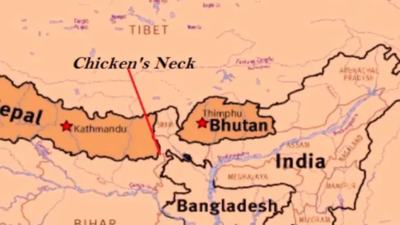- News
- City News
- guwahati News
- 'Chicken’s neck' explained: Why this narrow corridor is crucial for India’s connectivity and regional security
Trending
'Chicken’s neck' explained: Why this narrow corridor is crucial for India’s connectivity and regional security
The Siliguri Corridor, India's sole land link to the northeast, is in focus following remarks by Bangladesh's Muhammad Yunus. Indian leaders condemned his comments suggesting Bangladesh holds sway over ocean access for the northeastern states. This highlights the need for robust infrastructure to secure the region, with India exploring alternative routes through Bangladesh for better connectivity.
NEW DELHI: The Siliguri Corridor, a narrow stretch of land in West Bengal, is India's only land link to its eight northeastern states.
Often called the 'Chicken’s Neck', this critical chokepoint just 22 km wide at its narrowest point has long been a strategic vulnerability for India.
The corridor connects eight states Arunachal Pradesh, Assam, Manipur, Meghalaya, Mizoram, Nagaland, Sikkim, and Tripura to the rest of the country.
The region has now come under renewed focus following provocative remarks by Bangladesh's interim chief advisor Muhammad Yunus, who referred to India’s northeastern states as "landlocked" and positioned Bangladesh as their "guardian of ocean access."
His statement, made during a recent visit to China, has drawn sharp political reactions in India, with Assam chief minister Himanta Biswa Sarma calling it "offensive and strongly condemnable."

Former Manipur CM N Biren Singh also slammed Yunus, accusing Bangladesh of attempting to use the Northeast as a "strategic pawn."
Assam CM Himanta Biswa Sarma pointed out that the remarks highlight the "persistent vulnerability narrative" surrounding the Siliguri Corridor. He emphasized the need to develop robust railway and road networks both underneath and around the corridor to secure India’s Northeast.
Tipra Motha chief Pradyot Debbarma also weighed in, calling the loss of Chittagong Port in 1947 India’s "biggest mistake." He advocated for creating a new route to the ocean with support from indigenous communities, minimizing dependence on Bangladesh.
Former Manipur CM N Biren Singh issued a stern warning, stating that Bangladesh’s interim government must "exercise restraint" as "reckless comments about India will have consequences." Assam Jatiya Parishad (AJP) leaders also criticized Yunus, calling his statements "provocative and unacceptable."
Geopolitical significance of the Siliguri Corridor
Sandwiched between Nepal and Bangladesh, with Bhutan and China just a few hundred kilometers away, the Siliguri Corridor is vital for both civilian movement and military logistics.
Any disruption to this route poses a direct threat to India’s territorial integrity, making its security a top priority.
China’s expanding military infrastructure near the India-Bhutan-China tri-junction has further heightened tensions in the region.
The 2017 Doklam standoff underscored the corridor’s vulnerability, prompting India to ramp up its defenses. The presence of a single railway line through the corridor as the primary supply route remains a strategic concern, as it could be a target in case of hostilities.
India’s response and alternative connectivity plans
India has been actively exploring alternative routes to reduce its dependence on the Siliguri Corridor. Under Article VIII of the India-Bangladesh Trade Agreement (1980), India has been working on transit routes through Bangladesh to facilitate better connectivity.
A notable precedent was set in 1992 when India allowed Bangladesh to use the Tin Bigha corridor, enabling access to the Dahagram-Angarpota enclave. More recently, India has been developing a railway network through Bangladesh to improve connectivity between the Northeast and the rest of the country.
During the tenure of Sheikh Hasina, Bangladesh allowed India to use Chittagong Port via South Tripura's Sabroom sub-division, which is connected to the port through the Maitree Bridge over the Feni River. This move provided India with crucial access to the Bay of Bengal, alleviating some concerns over the ‘Chicken’s Neck’ bottleneck.

About the Author
Gopal KeshavEnd of Article
FOLLOW US ON SOCIAL MEDIA








